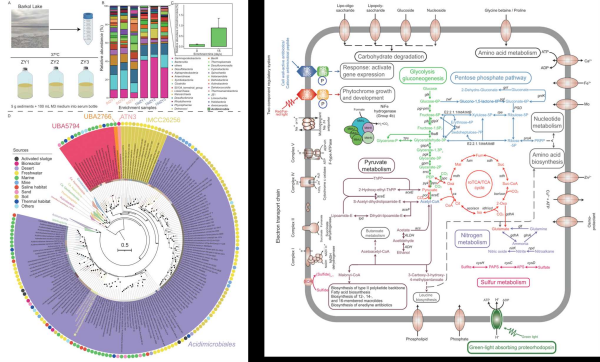Researchers Reveal Reversed Oxidative TCA (roTCA) for Carbon Fixation by an Acidimicrobiia Strain from a Saline Lake
2024-08-20
The class Acidimicrobiia represents a deeply rooted lineage within the phylum Actinomycetota, and is one of the difficult-to-cultured microbial taxa. Despite its widespread presence in nature, only several Acidimicrobiia pure culture strains have been isolated.
Previous studies have suggested that this taxon could survive under the chemolithoautotrophic condition through the Calvin-Benson-Bassham (CBB) cycle. However, direct evidence for chemolithoautotrophy within Acidimicrobiia remains lacking.
In a recent paper published in The ISME Journal, a research team led by Prof. LI Wenjun from the Xinjiang Institute of Ecology and Geography (XIEG) of the Chinese Academy of Sciences, constructed a chemolithoautotrophic enrichment system using saline lake sediments, and isolated and characterized a novel chemolithoautotrophic taxon (Salinilacustristhrixflava EGI L10123T) within the new family Salinilacustritrichaceae fam. nov. of the class Acidimicrobiia.
Although physiological experiments have indicated that strain EGI L10123T could grow chemolithoautotrophically, both its genome and metagenome-assembled genomes (MAGs) of Acidimicrobiia do not encode the key genes for the CBB cycle previously reported in other studies.
In this study, researchers demonstrated the chemolithoautotrophic carbon fixation activity of strain EGI L10123T through sulfide oxidation coupled with the reversed oxidative tricarboxylic acid cycle (roTCA) using genomics, transcriptomics, enzymatic activity, and stable isotope probing (SIP) evidence.They also found that genes for sulfide- or hydrogen-dependent roTCA carbon fixation were present in the common ancestor of Acidimicrobiia.
These findings could speculate that the roTCA carbon fixation mechanism is widespread among Acidimicrobiia.
"Our findings firstly provide deep insight into the diversity of Acidimicrobiia as well as the potential of roTCA operating in Acidimicrobiia, driven by sulfide oxidation and probably hydrogen oxidation," said FANG Baozhu, the corresponding author of this study.
This study also highlights the ecological potential of chemolithoautotrophic carbon fixation by Acidimicrobiia in various ecosystems.
Article link: https://pubmed.ncbi.nlm.nih.gov/39073917/

Chemolithoautotrophic enrichment and diversity of Acidimicrobiia (Image by XIEG)
Contact
LONG Huaping
Xinjiang Institute of Ecology and Geography
E-mail: longhp@ms.xjb.ac.cn
Web: http://english.egi.cas.cn



